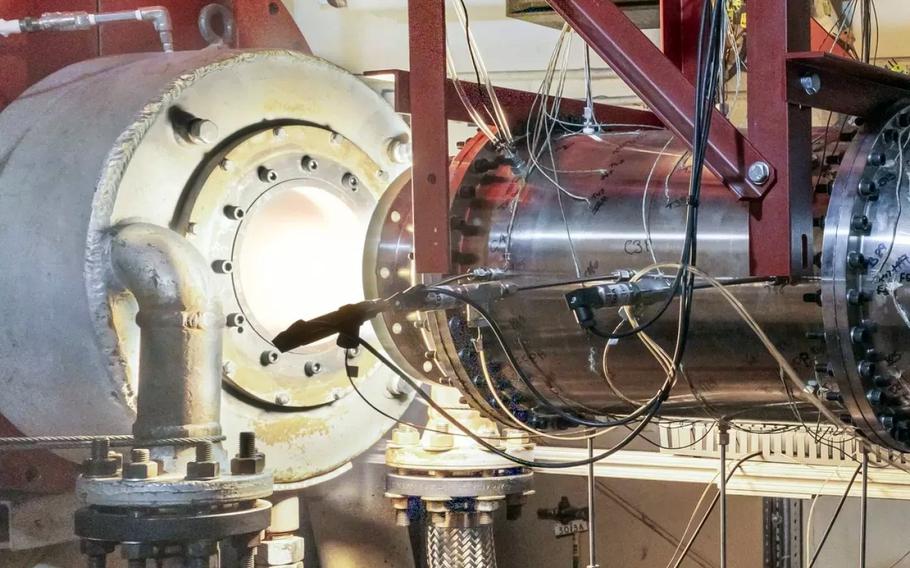
Scientists from the U.K.'s Defense Science and Technology Laboratory and the U.S. Air Force Research Laboratory carried out 233 successful static test runs of an air-breathing engine at the NASA Langley Research Center in Langley, Va. (U.K. Defense Ministry)
NAPLES, Italy — American and British researchers recently completed hundreds of successful tests of an engine capable of propelling a cruise missile at hypersonic speed, demonstrating what officials are calling a critical breakthrough in countering asymmetric Russian and Chinese threats.
Some 233 engine trials at a range of speeds, including Mach 5 — or about 3,400 mph — were conducted over six weeks at the NASA Langley Research Center in Virginia, the U.K. Defense Ministry said in a statement Sunday. Mach 5 is the threshold for hypersonic speed, which is five times the speed of sound.
The tests demonstrated the performance of “the high-speed air-breathing engine — enabling greater ranges than a conventional rocket,” the U.K. said, adding that the achievement was a significant step in European defense.
It wasn’t clear exactly when the tests were conducted but they involved “real-time data analysis to refine design aspects and boost propulsive performance,” according to the statement.
Air-breathing engines use air to create the chemical reaction needed for fuel combustion, eliminating the need for a separate onboard system.
The technology allows a missile to sustain flight at hypersonic levels — Mach 5 or greater — permitting it to potentially evade an enemy’s defense system, according to defense contractor Raytheon.
In comparison, a subsonic cruise missile such as a Tomahawk would take about an hour of flight time to reach a target 500 miles away. A hypersonic cruise missile would make the journey in less than 10 minutes, according to the Atlantic Council, a Washington D.C.-based think tank.
The U.S. has progressed over the last five years in developing hypersonic strike weapons but has failed to field its first weapon, the Atlantic Council said in a report published March 12.
Meanwhile, Russia and China have aggressively pursued development of long-range hypersonic weapons, fielding several types that put U.S. land and sea bases at significant risk, wrote Michael White, the report’s author.
For example, a Russian frigate armed with hypersonic Zircon missiles trained with the Chinese and South African navies in February 2023. That same year, Russia’s largest shipbuilder said the country’s newest nuclear submarines were being outfitted with the same missiles.
“Russia has developed and deployed a nuclear-armed hypersonic weapon that holds the U.S. mainland at risk from a highly survivable nuclear first strike,” White wrote.
He added that potential adversaries, such as North Korea and Iran, also reportedly have developed and deployed hypersonic weapons.
Last fall, the U.S., the U.K. and Australia signed an agreement allowing the three countries to use one another’s testing facilities and share technical information to develop, test and evaluate hypersonic weapons, the Defense Department said in a Nov. 18 statement.
The agreement, which established the Hypersonic Flight Test and Experimentation Project Arrangement, includes existing U.S. efforts and up to six trilateral flight test campaigns by 2028 with a funding pool of $252 million, the Pentagon said.
The agreement is part of the AUKUS security pact for the Indo-Pacific region.
The recent U.K. tests were coordinated with the Air Force Research Laboratory, the U.K. Defense Science and Technology Lab, and industry partners.
“This milestone moment on hypersonics research, supported by British scientists and British small businesses, demonstrates another crucial area where we are working in lockstep with the U.S. to bolster our Armed Forces and strengthen our deterrence,” U.K. Defense Secretary John Healy said in the statement Sunday.